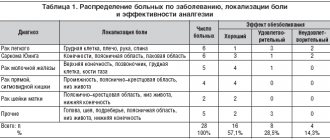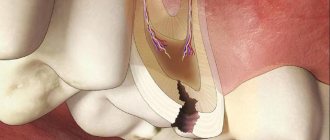Inflammation of the facial nerve is an unpleasant ailment that does not go away painlessly. The main complaints of patients are sharp attacks of pain in the face, in the upper and lower jaws.
This inflammation is considered one of the most common among facial pains. Most often, the disease proceeds without a trace, but if treatment is neglected, paralysis may occur.
The disease most often occurs in women over 50 years of age; men are treated with this disease much less frequently. People with a genetic predisposition, such as a narrow bone canal, are also at risk. Due to this anatomical feature, there is an increased risk of pinching due to impaired blood supply and various inflammations.
What is the facial nerve?
The trigeminal nerve, also known as the facial nerve, is the largest of the twelve cranial nerves. It originates in the ear, after which it branches, the first path reaches the frontal part, the second is located at the jaw. The nerve goes around almost the entire surface of the human face; it literally controls it.
Every person has two facial nerves - one on each side of the head. It is in contact with other cranial nerves and has supersensitive fibers.
Doctors divide the disease into two types - primary and secondary. The primary one manifests itself as a complication from a cold, in this case the normal nutrition of the nerve is disrupted. Secondary occurs with severe intoxication against the background of inflammatory or infectious diseases, as well as tumor processes.
Causes of eye pain
There are several serious diseases whose symptoms include pain inside the eye. Many of them require urgent treatment, so establishing the true cause of pain inside the eyes must occur quickly.
The main etiological factors that cause acute pain inside the eyeball are the following:
- Angle-closure glaucoma. The pathology is caused by a sharp increase in intraocular pressure due to improper circulation of ocular fluid. With this anomaly, pain can occur suddenly and increase at a high rate. In addition to pain in the eyeball, this condition is accompanied by visual disturbances - scotoma, rapid increase in myopia, changes in color vision, a feeling of strong pressure in the eyes, headache and nausea.
- An attack of ocular hypertension provoked by a violation of the circulation of the intraocular fluid. Increased pressure inside the eye worsens in the morning and can spontaneously subside in an upright position. In addition to discomfort, an increase in the vascular pattern on the conjunctiva is observed directly in the eye, and sometimes hemorrhage in the membrane of the eye.
- Increased intracranial pressure due to traumatic brain injury, hemorrhagic stroke, cerebral hematomas, meningitis and encephalitis, tumors and other pathologies. With this anomaly, patients complain of periodically increasing pain inside the eye. Symptoms increase when lying down, when coughing, sneezing, or other types of stress. Additionally, there is a slight decrease in visual acuity, which can progress with increased pain.
- Neuralgia of the trigeminal or supraorbital nerve. In such conditions, pain inside the eye is localized on one side and limited to the cheekbone, part of the nose with damage to the trigeminal nerve or the orbit of the eye, brow ridge and part of the forehead with supraorbital neuralgia. Additional symptoms are lacrimation on the affected side, increased pain when trigger points are irritated.
- Optic neuritis due to sinusitis, damage to the myelin sheath (sclerosis), inflammation of the orbit. The pathology is accompanied by pain inside the eyeball that intensifies when turning, a change in the perception of colors, a decrease in visual acuity and the appearance of spots in the visual field.
- Inflammation of the eyeball. The patient complains of acute constant pain inside the eye and increased body temperature. Visually visible swelling of the conjunctiva, redness of the eyelids, decreased vision on the affected side.
Pain syndrome inside the eye is also provoked by cluster headaches and migraines. Such anomalies are more common in women of fertile (childbearing) age. The pain in most cases is paroxysmal, intense, occurs suddenly, and lasts from several hours to several days. In addition to pain inside the eye, the condition is accompanied by lacrimation on the affected side, inflammation and redness of the cornea, general depression, attacks of irritability, intolerance to light, sounds, etc.
In isolated cases, behind the symptoms of inflammation of the eyeball, neuritis and neuralgia, glaucoma and other ophthalmological pathologies, another anomaly is hidden that is not related to the visual organs. Most often they are sinusitis, frontal sinusitis, gumboil, deep damage to the roots of teeth by caries.
Causes of inflammation of the trigeminal nerve on the face
Usually the disease is caused by infection or bacteria. List of reasons why inflammation of the facial nerve may occur:
- Temporomandibular joint injuries
- Tumors (benign and malignant) of the brain and facial area
- Anomalies of skull development
- Skull injuries - birth, fracture, base, damage to the face or jaw
- Polio
- Pulmonary tuberculosis
- Otitis
- Sinusitis
- Chronic caries
- Inflammation after tooth extraction or treatment
- Hypertension
- HIV and AIDS
- Poisoning
- Inflammation of the middle ear
- Severe hypothermia of the head
- Changes in hormonal levels in women
- Gum inflammation
- Ramsay Hunt syndrome
- Stroke
- Bell's palsy
Causes range from minor to life-threatening illnesses. Each of the reasons determines the further treatment of the patient. In some cases, special tests are performed for diagnosis - auditory, lacrimal, infectious, salivary or gustatory. In this way, the functioning of the receptors and sensory organs is checked.
Treatment
In accordance with the diagnosis, therapy is prescribed:
- for neuralgia, relieve pain with analgesics, lidocaine-based ointment, and drugs for vasodilation;
- antibacterial drops and ointments are used to treat otitis externa;
- drops against inflammation with an analgesic effect - for internal otitis;
- Ear infections are treated with penicillin and amoxicillin antibiotics - orally, by insertion into the ear through a catheter.
For more serious diagnoses, pain is relieved and the primary cause of symptoms is treated.
Symptoms of inflammation of the trigeminal nerve
Experts include short-term, but acute and intense pain in different parts of the head as the main symptoms of facial neuralgia. Shooting attacks spread over the entire surface of the face - lips, eyes, nose, upper and lower jaw, gums and tongue.
Patients also report the following symptoms:
- Metallic taste in the mouth
- Muscle weakness
- 2-3 days before facial expressions are affected, pain occurs behind the outer ear, spreading to the face, back of the head and eyes
- Facial asymmetry
- Inability to close the eye on the affected side
- Drooping corner of the mouth
- Dry mouth
- Slurred speech
- Cross-eyed strabismus
- Uncontrollable tearing
- Disorders of taste buds
- Increased drooling
- Facial muscle spasms
- Increased or decreased facial sensitivity
- Temperature increase
Due to discomfort and pain, the patient begins to develop a phobia and increased anxiety. He tries to avoid poses and movements that provoke discomfort.
Causes of pain
Painful sensations in the ear area and the right side of the head can occur due to inflammatory processes, as well as when the blood circulation in this area is impaired. The process can spread from the organ of hearing to part of the head and vice versa. When the first complaints appear, it is necessary to undergo an examination and determine their cause.
Otitis
Ear inflammation (otitis) can occur in adults and children. It occurs as a complication of viral diseases (ARVI, influenza), injuries, hypothermia or inflammation of the sinuses. At the first stage, the patient is bothered by constant pain in the ear, which spreads to the entire surface of the head. However, otitis media can progress and develop in several stages:
- aseptic inflammation, which causes aching pain;
- addition of a bacterial infection;
- development of purulent inflammation - accompanied by acute pain and hearing impairment;
- probable complications in the form of purulent melting of the eardrum, as well as the spread of infection to the inner ear and lining of the brain.
Otitis media is often chronic and appears annually. After an examination, an otolaryngologist will help you choose the most effective treatment regimen. It is important to pay attention to the first symptoms in time, since the chronic course of the inflammatory process can provoke partial or complete hearing loss.
Diseases of the external ear
The outer ear is the peripheral part of the hearing organ, which is separated from the middle part by the eardrum. Pathological processes in this area often manifest as acute pain in the right ear and head. With timely treatment, they resolve without complications, but in the absence of intervention they can spread to the middle and inner ear.
- Furunculosis, eczema, fungal skin infections - these processes are accompanied by inflammation and pain. The skin of the auricle turns red and peels, and ulcers (boils) may form on it. Treatment consists of external use of anti-inflammatory and antifungal drugs.
- Diseases that lead to the formation of cerumen plug - it forms deep in the ear canal, so it is impossible to remove it yourself. The cause may be anatomical features of the structure of the hearing organ or excessive formation of sulfur.
- Injuries, falls and bruises are another cause of inflammation of the outer ear. In young children, the process can be triggered by foreign objects entering the ear canal.
When diagnosing, it is important to assess the condition of the eardrum. Inflammatory processes can spread to it and even cause its perforation. Injuries that cause damage are also dangerous.
Inner ear diseases
Inflammation of the inner ear is the cause of acute pain in the right side of the head and in the ear. The organ has a complex structure and is responsible not only for hearing, but also for balance. It is presented in the form of channels and labyrinths filled with liquids. This is where bacteria multiply, causing inflammation.
Diseases of the inner ear require immediate treatment; in most cases, antibiotic therapy is used for this. The tympanic cavity is a comfortable environment for the growth of bacteria, and they can cause purulent inflammation. This leads to hearing loss, constant headaches, and the development of complications, including acute meningitis - inflammation of the membranes of the brain.
Change in blood pressure
An increase or decrease in blood pressure is a common reason why the right ear and the right side of the head hurt. Hypertension (high blood pressure) occurs due to insufficient elasticity of blood vessels, nervous tension and other factors. It manifests itself with characteristic symptoms:
- pressing headache that spreads to the back of the head, temple, and may affect the ear;
- deterioration of hearing and vision, the appearance of tinnitus;
- redness of the skin and mucous membranes, the appearance of small capillary hemorrhages.
With a decrease in pressure (hypotension), an increase in heart rate, weakness, and impaired coordination of movements are observed. The skin and mucous membranes may become pale. Insufficient oxygen supply to the brain is dangerous, as it can provoke a stroke or transistor ischemic attacks.
Stroke
Acute cerebrovascular accident is a stroke. It occurs when there is a sudden stop in the flow of oxygen-rich blood to certain areas of the brain. There are ischemic (manifested by blockage, compression of a vessel, low blood pressure) and hemorrhagic (the result of damage to an artery and hemorrhage in the brain) stroke. The first type is more common and is manifested by the following symptoms:
- sudden headache, often one-sided, which may affect the ear;
- impaired coordination of movements;
- weakening of the facial muscles on the injured side;
- discomfort and pain behind the sternum;
- impaired diction, the appearance of memory lapses;
- loss of consciousness.
The main reason why strokes occur is the lack of early diagnosis. Doctors at the Clinical Brain Institute recommend undergoing regular scheduled examinations to identify cardiovascular diseases in the early stages. Monitoring blood pressure, proper nutrition and dosed exercise, as well as systematically taking medications as needed are the basis for preventing stroke at any age.
Pain in the ear and right side of the head due to neuralgia
If your head hurts and radiates to your right ear, this may be a sign of neuralgia. This is not a separate disease, but a type of pain that occurs when a nerve is inflamed or damaged. The trigeminal nerve is most often affected, which gives off branches to the muscles of the face, the organ of hearing, the upper and lower jaws.
Neuritis is an inflammatory process that develops in nerve fibers. It is accompanied by acute throbbing pain, which can be one-sided, affecting part of the head, ear and half of the face. It intensifies with sharp sounds, bright lighting and other irritants, as well as with chewing and turning the head. Treatment consists of taking painkillers and anti-inflammatory drugs. If they are ineffective, a nerve block is indicated - injections along its course with anesthetics and hormonal anti-inflammatory drugs.
Diseases of the cervical spine
The cervical spine contains arteries that carry blood from the heart to the brain, analyzer organs, muscles and facial skin. Their mechanical pinching leads to impaired sensitivity in certain areas and chronic headaches. Normally, the vessels are located in the canals formed by the processes of the vertebrae, and blood moves freely through them. However, there are a number of diseases that lead to poor circulation, pain in the head and ear:
- osteochondrosis is a pathology of intervertebral discs, in which they become fragile and cannot absorb movement, and the distance between adjacent vertebrae decreases;
- spondylosis - fusion of two or more adjacent vertebrae as a result of injury, inflammatory or dystrophic changes, destruction of cartilage;
- curvature of the spine, most often cervical scoliosis;
- chondrocalcinosis - deposition of salts in the periarticular tissues, which leads to decreased joint mobility;
- intervertebral protrusions and hernias - protrusion of intervertebral discs, their gradual erasure until the outer fibrous membrane ruptures;
- vertebral displacement.
Spinal diseases often manifest as headaches. It can be one-sided, since the load on the spinal column becomes uneven, and mechanical compression of the vessels and nerves occurs.
Inflammation of the lymph nodes
Lymphadenitis is inflammation of the lymph nodes. Pain in the right ear and right side of the head can be caused by damage to the parotid lymph nodes. It is acute, pulsating, and may be accompanied by fever. The disease occurs as a complication of a viral infection of the upper respiratory tract; a bacterial or fungal pathogen can also be diagnosed.
With lymphadenitis, redness of the skin behind the ears and the appearance of a hard lump may be observed. The local temperature is increased and pulsation is felt. Treatment consists of taking antibiotics, anti-inflammatory drugs, and painkillers.
Diagnosis of inflammation of the trigeminal nerve
Depending on the affected area and the set of symptoms, the strategy for diagnosing the disease is determined. To determine the location of nerve damage, the severity and dynamics of recovery, doctors prescribe a hardware diagnostic method, for example, electromyography. MRI and CT scans are used to determine the presence of tumors in the brain.
The patient may also be referred for a general or biochemical blood test, x-ray of the lungs, ultrasound of soft tissues or ophthalmoscopy.
You can be confident in the quality of the procedures performed in the clinic and the high accuracy of the results of MRI, CT and other methods of diagnosing various diseases. Medunion performs magnetic resonance imaging of all types: head, spine, abdominal cavity and joints using modern equipment.
Diagnosis of pain inside the eye
To diagnose eye pain, a comprehensive ophthalmological examination is performed. Before it, instillation of analgesics is recommended, since pain leads to blepharospasm, which complicates examination. After this, visual and instrumental studies are carried out:
- visometry - measuring visual acuity using tables;
- non-contact tonometry - measurement to detect increased pressure inside the eyes;
- biomicroscopy - examination of the front side of the eyeball using a slit lamp, revealing corneal defects, inflammation and other pathologies;
- ophthalmoscopy - measurement of the transparency of the optical media of the eye and visual examination of the retina for pathologies;
- Ultrasound of the eyeball is a wave diagnostic method that helps diagnose developmental anomalies and defects of all eye structures;
- X-ray of the eye is a radiation diagnostic method that detects foreign bodies and defects of bone structures in the orbital area.
If a secondary nature of pain is suspected, general studies are carried out: blood and urine tests, tests for specific and nonspecific microflora, functional diagnostics.
Treatment for inflammation of the facial nerve
Drug treatment
Treatment of trigeminal neuritis is complex. The disease is first treated with medication - the patient is prescribed drugs that will alleviate the situation. These include painkillers, decongestants, vasodilators and B vitamins. Most often, the recommended medications are tablets, but you can speed up the recovery process by using ointments and gels. Sometimes doctors prescribe intramuscular injections.
In special cases, the recovery process of the facial nerve may be slowed down. Then the patient is prescribed glucocorticosteroids, which improve the metabolic processes of nervous tissue. Various biostimulants and hyaluronidases also contribute to a speedy recovery.
You cannot prescribe medications for yourself. Be sure to see a neurologist or neuropathologist at the first symptoms to determine the diagnosis and treatment strategy. Recovery medications are recommended to patients on a case-by-case basis, paying attention to the presence of chronic diseases, symptoms, and so on.
Surgery
Another way to treat the facial nerve is surgery. However, doctors turn to this option quite rarely - only when the trigeminal nerve is ruptured. Surgery is also required if there is no effect from the conservative method after six months or a year. Surgical intervention is only relevant during the first year of the presence of the disease; later, the muscles on the face irreversibly atrophy.
The surgical process involves suturing the damaged area of the facial nerve to restore its motor function.
Massage
The next treatment method is massage for the treatment of the facial nerve. The purpose of this method is to remove swelling, improve blood circulation, restore sensitivity and conduction of nerve impulses. Massage is contraindicated for tuberculosis, oncology, atherosclerosis and elevated temperature.
Initially, the massage therapist works only with the healthy side of the face, collar area, neck and area above the shoulders. Basically, the master uses rubbing, stroking, kneading and vibration.
For noticeable desired changes, it is necessary to conduct ten to twenty massage sessions from five to fifteen minutes. The duration is determined based on the degree of inflammation of the trigeminal nerve, the goals of therapy and the dynamics of recovery.
Physiotherapy
The next treatment method is physical therapy. It alleviates the severity of symptoms, helps to activate metabolic processes in tissues and restore the functions of the facial nerve.
Doctors prescribe this course of treatment from the first days of the onset of neuritis. The list of physical procedures includes:
- Ultrasound
- Laser irradiation of blood
- Electrophoresis of drugs
- Microwave therapy
- Exposure to ultra-high frequency electricity
- Ozocerite treatment
- Myoelectrostimulation
- Darsonvalization
This complex is indicated for the first week of treatment. Doctors prescribe it together with medication. This tandem helps speed up the process of restoration of the facial nerve. And its most important advantages are the absence of side effects and painlessness.
Alternative Methods
There are also alternative treatment methods. These are procedures aimed at restoring facial muscles and eliminating the symptoms of facial neuritis. Such procedures include:
- Clay or paraffin masks
- Acupuncture
- Reflexology
- Injections to eliminate muscle disorders
- Therapeutic baths
- Taping – stretching the face using adhesive plasters
- Immunosorption – purification of blood from antigens and antibodies
- Biofeedback – facial muscle training
Gymnastics for the face
Also, in conjunction with complex treatment, you can do facial exercises. Before this, you need to consult with a specialist; the doctor will draw up an individual list of exercises based on the severity of the process, location of the lesion and symptoms. Typically, such gymnastics takes about ten minutes a day.
A standard set of exercises includes relaxing and tensing individual facial muscles. For example, to restore articulation, it is recommended to pronounce the sounds “u”, “o”, “and”. Afterwards, you need to bring your lower lip under your upper teeth and reproduce the sounds “v” and “a”.
Gymnastics for inflammation of the trigeminal nerve:
- Close eyes
- Raise your eyebrows
- Frown
- Squint
- Smile with your mouth closed
- Smile with your mouth open
- Puff up your cheeks
- Pull them back
- Whistle
- Widen your nostrils
- Curl your lips
- Raise your upper lip and return to the starting position
- Lower your lower lip and return to the starting position
- Take water into your mouth
- Rinse your mouth
- Close your mouth
- Run the tip of your tongue along your gums
- Move your tongue right and left
When to contact a specialist
The appearance of a throbbing headache is already a “bell” that you need to see a doctor and get checked. And few people know that there are situations that oblige the patient to contact a specialist to alleviate the condition, and sometimes even save a life.
If you notice that:
- The pain lasts for more than one hour, and medications do not help.
- The pulsation becomes stronger, despite the fact that the patient does nothing.
- Pain in the occipital region appears immediately after a person wakes up or awakening occurs due to unbearable sensations that do not allow doing anything.
- A buzzing sensation is often felt in a certain area of the head.
- The pain causes dizziness, nausea, vomiting, partial paralysis, clouding of consciousness, and inability to speak normally.
- Intense pulsating beats that do not stop for several days.
- Changes in blood pressure, which are accompanied by headaches.
- The nature of the throbbing pain constantly changes.
If you notice any of the above changes, you should immediately consult a doctor or an ambulance, as serious problems may be hidden behind this.
Disease prevention
Doctors recommend eliminating effects on the body that cause inflammation of the trigeminal nerve. Here are some recommendations to help avoid illness:
- Avoid drafts and hypothermia
- Keep your head warm during the cold season
- Monitor your blood pressure
- Timely treatment of infectious and bacterial diseases
- Have a routine check-up with an oncologist
- Avoid skull and head injuries
You can sign up for an individual consultation, take tests or undergo treatment at the Medunion private clinic. You can easily make an appointment with us by calling 202-95-54 or online, directly on the website, by clicking on the “Online booking” button.
We have been working in Krasnoyarsk since 2006 and provide high-quality medical services to the population. The staff consists of highly qualified doctors of broad and narrow specialization.
Prevention of eye pain
There are no specific uniform measures to prevent eye pain, since the causes of its occurrence are diverse. To reduce the risk of their occurrence, ophthalmologists advise regular follow-up with them, as well as with doctors of other specializations. The risk of abnormalities that provoke intraocular pain can be reduced by following the general principles of a healthy lifestyle, personal hygiene, and visual hygiene:
- periodically give your eyes rest;
- Use eye protection when working with chemicals, working in contaminated areas or in bright light;
- systematically perform eye exercises;
- use prescription glasses for working with documents and watching TV if you have visual impairments;
- monitor the light level when working with documents, etc.
Patients of any age should consult a doctor immediately after the first unpleasant symptoms appear. This will allow the ophthalmologist to detect the source of the malaise in time and eliminate the problem at an early stage.
Drills temples
This sensation of pain, popularly described as “drilling in the temples,” occurs with low blood pressure and accompanies a tension headache or an attack of cluster pain. Tension pain is most common among people with mental work (desk and chair workers). It helps to perform a manual massage of the head or shoulder girdle, rest for several minutes in a horizontal position, get a good night's sleep and take breaks from work.
With cluster pain, everything is much more complicated. Such pain is quite rare (in five out of six cases in men), the causes of pain are still unclear. Symptoms of such pain are pain in one side of the head.










